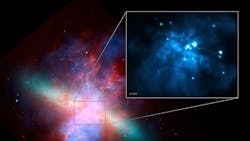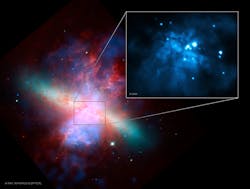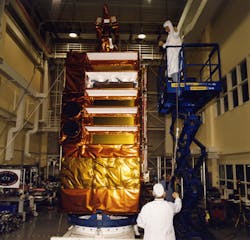Instruments on NASA’s Rossi X-ray Timing Explorer (RXTE) satellite helped astronomers discover rhythmic pulsations from a rare type of black hole. The unusual midsize “M82X-1” black hole, some 12 million light years away, is the brightest X-ray source in the galaxy. A proportional counter array (PCA), a high energy X-ray timing experiment (HEXTE), and an all-sky monitor (ASM) were used to identify its rhythmic pulses known as quasi-periodic oscillations (QPOs).
The PCA consists of five proportional counters that send event data to the experiment data system (EDS), which consists of eight event analyzers (EAs). According to the paper Advances in the RXTE Proportional Counter Array Calbiration: Nearing the Statistical Limit, authored by NASA scientists, “The PCA is the primary instrument on-board RXTE which provides data in 3-50 keV energy range with sub-millisecond time resolution in up to 256 energy channels.” It was built by the Laboratory for High Energy Astrophysics at Goddard Space Flight Center.
The HEXTE consists of two clusters, each containing four phoswitch scintillation detectors. Each cluster is capable of beamswitching along mutually orthogonal directions to provide background measurements. The instrument’s data system processes captured events, such as event modes, binned spectra, light curves, and burst-triggered event buffers, before inserting them into the telemetry stream. It was designed and built by the Center for Astrophysics & Space Sciences (CASS) at the University of California.
The ASM utilizes three scanning shadow cameras (SSCs) equipped with proportional counters. The three SSCs, mounted on a motorized rotation drive, each contain a position-sensitive proportional counter (PSPC) that views the sky through a slit mask. It then measures the displacements and strengths of the shadow patterns cast by X-ray sources within the field of view, inferring the sources’ direction and intensity. It was built by the Center for Space Research (CSR) at the Massachusetts Institute of Technology (MIT).
Watch the video from NASA Goddard below for more on RXTE's black hole discovery:
After analyzing six years of RXTE data, specific changes in brightness helped the team determine that the M82X-1 measures approximately 400 solar masses. The scientists located X-ray variations that reliably repeat about 5.1 and 3.3 times a second, or a 3:2 relationship. The combined presence of slow QPOs and a faster pair in the 3:2 rhythm set the standard for proving the mass of the black hole. All results were published in the Nature journal of science.
About the Author
Iliza Sokol
Associate Digital Editor
Iliza joined the Penton Media group in 2013 after graduating from the Fashion Institute of Technology with a BS in Advertising and Marketing Communications. Prior to joining the staff, she worked at NYLON Magazine and a ghostwriting firm based in New York.


